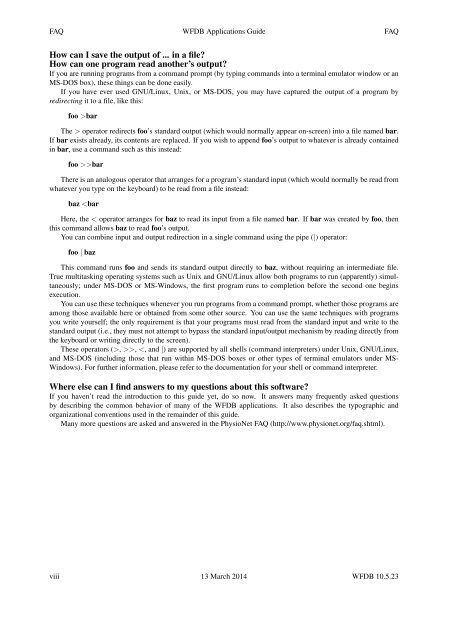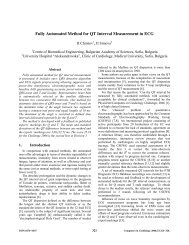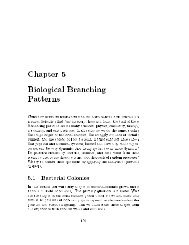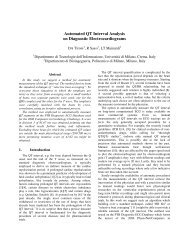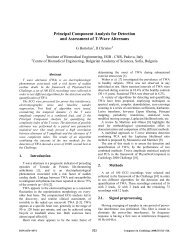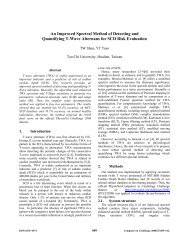- Page 1 and 2: WFDB Applications Guide Tenth Editi
- Page 3 and 4: Contents WFDB Applications Guide Co
- Page 5 and 6: Introduction WFDB Applications Guid
- Page 7: FAQ WFDB Applications Guide FAQ Fre
- Page 11 and 12: A2M(1) WFDB Applications Guide A2M(
- Page 13 and 14: ANN2RR(1) WFDB Applications Guide A
- Page 15 and 16: ANN2RR(1) WFDB Applications Guide A
- Page 17 and 18: BXB(1) WFDB Applications Guide BXB(
- Page 19 and 20: CALSIG(1) WFDB Applications Guide C
- Page 21 and 22: DFA(1) WFDB Applications Guide DFA(
- Page 23 and 24: ECGEVAL(1) WFDB Applications Guide
- Page 25 and 26: ECGPUWAVE(1) WFDB Applications Guid
- Page 27 and 28: EDF2MIT(1) WFDB Applications Guide
- Page 29 and 30: EDR(1) WFDB Applications Guide EDR(
- Page 31 and 32: EPICMP(1) WFDB Applications Guide E
- Page 33 and 34: FFT(1) WFDB Applications Guide FFT(
- Page 35 and 36: FIR(1) WFDB Applications Guide FIR(
- Page 37 and 38: GQFUSE(1) WFDB Applications Guide G
- Page 39 and 40: GQRS(1) WFDB Applications Guide GQR
- Page 41 and 42: HRFFT(1) WFDB Applications Guide HR
- Page 43 and 44: IHR(1) WFDB Applications Guide IHR(
- Page 45 and 46: IMAGEPLT(1) WFDB Applications Guide
- Page 47 and 48: LOMB(1) WFDB Applications Guide LOM
- Page 49 and 50: LWCAT(1) WFDB Applications Guide LW
- Page 51 and 52: MEMSE(1) WFDB Applications Guide ME
- Page 53 and 54: MRGANN(1) WFDB Applications Guide M
- Page 55 and 56: MXM(1) WFDB Applications Guide MXM(
- Page 57 and 58: NGUESS(1) WFDB Applications Guide N
- Page 59 and 60:
NST(1) WFDB Applications Guide NST(
- Page 61 and 62:
NST(1) WFDB Applications Guide NST(
- Page 63 and 64:
PARSESCP(1) WFDB Applications Guide
- Page 65 and 66:
PARSESCP(1) WFDB Applications Guide
- Page 67 and 68:
PLOTxD(1) WFDB Applications Guide P
- Page 69 and 70:
PLT(1) WFDB Applications Guide PLT(
- Page 71 and 72:
PLT(1) WFDB Applications Guide PLT(
- Page 73 and 74:
PLT(1) WFDB Applications Guide PLT(
- Page 75 and 76:
PLTF(1) WFDB Applications Guide PLT
- Page 77 and 78:
PNNLIST(1) WFDB Applications Guide
- Page 79 and 80:
PSCHART(1) WFDB Applications Guide
- Page 81 and 82:
PSCHART(1) WFDB Applications Guide
- Page 83 and 84:
PSFD(1) WFDB Applications Guide PSF
- Page 85 and 86:
PSFD(1) WFDB Applications Guide PSF
- Page 87 and 88:
RDANN(1) WFDB Applications Guide RD
- Page 89 and 90:
RDEDFANN(1) WFDB Applications Guide
- Page 91 and 92:
RDSAMP(1) WFDB Applications Guide R
- Page 93 and 94:
RXR(1) WFDB Applications Guide RXR(
- Page 95 and 96:
SETWFDB(1) WFDB Applications Guide
- Page 97 and 98:
SIGAMP(1) WFDB Applications Guide S
- Page 99 and 100:
SIGNAME(1) WFDB Applications Guide
- Page 101 and 102:
SKEWEDIT(1) WFDB Applications Guide
- Page 103 and 104:
SORTANN(1) WFDB Applications Guide
- Page 105 and 106:
SQRS(1) WFDB Applications Guide SQR
- Page 107 and 108:
STEPDET(1) WFDB Applications Guide
- Page 109 and 110:
SUMSTATS(1) WFDB Applications Guide
- Page 111 and 112:
TA CH(1) WFDB Applications Guide TA
- Page 113 and 114:
WABP(1) WFDB Applications Guide WAB
- Page 115 and 116:
WAV2MIT(1) WFDB Applications Guide
- Page 117 and 118:
WAVE(1) WFDB Applications Guide WAV
- Page 119 and 120:
WAVE(1) WFDB Applications Guide WAV
- Page 121 and 122:
WAVE(1) WFDB Applications Guide WAV
- Page 123 and 124:
WAVE(1) WFDB Applications Guide WAV
- Page 125 and 126:
WAVE(1) WFDB Applications Guide WAV
- Page 127 and 128:
WFDB2MAT(1) WFDB Applications Guide
- Page 129 and 130:
WFDBCAT(1) WFDB Applications Guide
- Page 131 and 132:
WFDBCOLLATE(1) WFDB Applications Gu
- Page 133 and 134:
WFDBMAP(1) WFDB Applications Guide
- Page 135 and 136:
WFDBWHICH(1) WFDB Applications Guid
- Page 137 and 138:
WQRS(1) WFDB Applications Guide WQR
- Page 139 and 140:
WRSAMP(1) WFDB Applications Guide W
- Page 141 and 142:
XFORM(1) WFDB Applications Guide XF
- Page 143 and 144:
WFDB(3) WFDB Applications Guide WFD
- Page 145 and 146:
WFDB(3) WFDB Applications Guide WFD
- Page 147 and 148:
WFDBF(3) WFDB Applications Guide WF
- Page 149 and 150:
ANNOT(5) WFDB Applications Guide AN
- Page 151 and 152:
HEADER(5) WFDB Applications Guide H
- Page 153 and 154:
HEADER(5) WFDB Applications Guide H
- Page 155 and 156:
HEADER(5) WFDB Applications Guide H
- Page 157 and 158:
HEADER(5) WFDB Applications Guide H
- Page 159 and 160:
SIGNAL(5) WFDB Applications Guide S
- Page 161:
WFDBCAL(5) WFDB Applications Guide
- Page 165 and 166:
Evaluating ECG Analyzers George B.
- Page 167 and 168:
Evaluating ECG Analyzers WFDB Appli
- Page 169 and 170:
Evaluating ECG Analyzers WFDB Appli
- Page 171 and 172:
Evaluating ECG Analyzers WFDB Appli
- Page 173:
Evaluating ECG Analyzers WFDB Appli


